You’re scanning a list of potential leads—names, companies, industries—all cold, unknown territory. They don’t know you exist, but you know they could be a perfect fit.
This is the moment when sales prospecting begins.
Before a lead becomes a warm email in your inbox, you have to find them, research their needs, and craft that first point of contact. It’s about identifying who’s worth pursuing, understanding their challenges, and reaching out with value.
The right outreach, message, and timing could turn this lead into your next big client. Discover the most tried-and-tested sales prospecting techniques to nurture and convert prospects into loyal customers.
What makes B2B prospecting so difficult?
B2B prospecting is hard work. In 2025, you have to slog through inboxes, catapult over competitors, climb your way up the corporate ladder to the right decision-maker, and do it all at the same time.
Here are some obstacles to prospecting that your fellow salespeople are experiencing:
Limited time
Market competition
Resource constraints
Evolving consumer behavior
Information overload
Privacy regulations
Economic uncertainty
Fluctuating market conditions, like the housing market, interest rates, potential tariffs, and the employment rate, along with other speed bumps, produce overly cautious customers, making it that much harder to convince them to enter new business relationships. You can overcome these challenges with the right blend of B2B prospecting methods and tools.
Inbound vs. outbound sales prospecting
You’re in a marketplace where some vendors are shouting to sell their wares, hoping to grab the attention of passersby, while others quietly build relationships with customers who come back time and again.
This is the difference between inbound and outbound sales prospecting.
Inbound prospecting involves attracting interest and letting potential customers come to you using content and social media marketing techniques. The goal is to have prospects come to you based on interest sparked through your online presence or by using your product during a trial period.
On the other hand, outbound prospecting involves proactively initiating the conversation using direct emailing, cold calling, or paid ads. The goal is to reach potential customers directly and generate interest by getting your product or service in front of them.
What makes a good sales prospect?
A good sales prospect fits the profile of your ideal customer and is highly likely to benefit from and purchase your product.
Here are some attributes of a good sales prospect:
Clear need: Your product can solve their need or pain point. For example, a company struggling with workflow issues is an ideal prospect for a project management software company.
Decision-making authority: Your ideal prospect must have the authority to make purchasing decisions or influence decision-making.
Sufficient budget: Your sales prospect must be able to afford your solution. Otherwise, your sales team will end up wasting time, resources, and prospecting efforts on someone who doesn’t have the budget.
Fit within your ideal customer profile (ICP): Your prospect should match the characteristics of your ideal customer profile, including company size, industry, and geographical location.
Engagement with your brand: Prospects who have already interacted with your brand, including visiting your website or following your social media, are more likely to convert into customers.
Sales cycle stage: Prospects are at a stage in the sales funnel where they’re ready to evaluate solutions.
It’s not just about finding the prospects. It’s about finding the prospects who need your product and are interested in it.
8 savvy B2B sales prospecting strategies
Whether you reach out via email, social media, or a quick video, your sales strategy can make or break your conversion rate. Here are 8 actionable tips to help you personalize your sales process and win over your target prospects.
1. Diversify your sales channels
Say you’re a DJ at a wedding, spinning records for a packed dance floor. You play one track, and the crowd goes wild. Then you play another, and they scatter to grab drinks.
In sales, like DJing, success often depends on knowing when to read the room and change things. Diversifying your sales channels can keep the party going and reach potential customers wherever they’re most active.
Each channel—social media platforms, email, direct mail, online ads, and more—provides an avenue to connect with prospects, decision-makers, and even referrals, helping you attract new leads throughout the sales cycle.
Here’s how to build a multichannel ecosystem to draw in more customers:
Understand your target audience
Research where your audience spends their time. For example, if you’re targeting younger, highly engaged audiences, you might lean into platforms like TikTok and Instagram. On the other hand, LinkedIn will be more suitable if you want to reach professionals or specific industries, especially for thought leadership and B2B networking.
Use tools like Google Analytics to analyze your website traffic, conduct surveys, or use built-in social media insights to understand where your audience engages most. Platforms like Facebook Audience Insights can also give you demographic information about your followers.
Test and measure new channels
Treat each new channel as an experiment—start small, measure engagement, and adjust accordingly. Launch small campaigns on different platforms such as email, social media, or even direct mail, and then track metrics like open rates, click-through rates, and conversion rates to see which channels yield the best results.
You can also implement A/B testing to further fine-tune your approach, especially for email outreach, subject lines, and call-to-action (CTA) placements.
Create platform-specific content
Just as radio, TV, and streaming services each require different ad formats, your sales content should be tailored to each unique channel.
For example, short, eye-catching videos perform well on TikTok and Instagram Reels, whereas detailed, informative blog posts are better suited for a company website or LinkedIn.
2. Interactive email campaigns
Are your emails being ignored? You’re not alone. Studies show that only about 34% of sales emails get opened.
If you’re still waiting for that elusive response, the solution might be simpler than you think: improve your sales prospecting techniques.
Here are some tweaks you can make to your cold emailing strategy to improve your returns:
Craft a personalized subject line and content
The subject line is your first impression—and you only have one shot. Studies reveal that emails with personalized subject lines are 26% more likely to be opened. To stand out, use the prospect’s first name, mention their company, or highlight a pain point relevant to them.
Once the subject line gets you in the door, make sure the body of your email continues this personal touch to close deals. Address their pain points and show you’ve done your homework.
This means instead of “We can help improve your marketing strategy,” say, “I noticed your company recently launched a new product—here’s how we can help amplify your digital marketing efforts to reach your ideal audience.”
Offer value-based solutions right away
Don’t just introduce yourself—lead with value. Prospects care more about how you can solve their problems than about your company’s background.
The first sentence of your email should focus on their specific needs.
For example, TurboTax addresses a user’s pain point with emails like, “Welcome to your personalized tax guide, starting with our top three tips to save you money.”
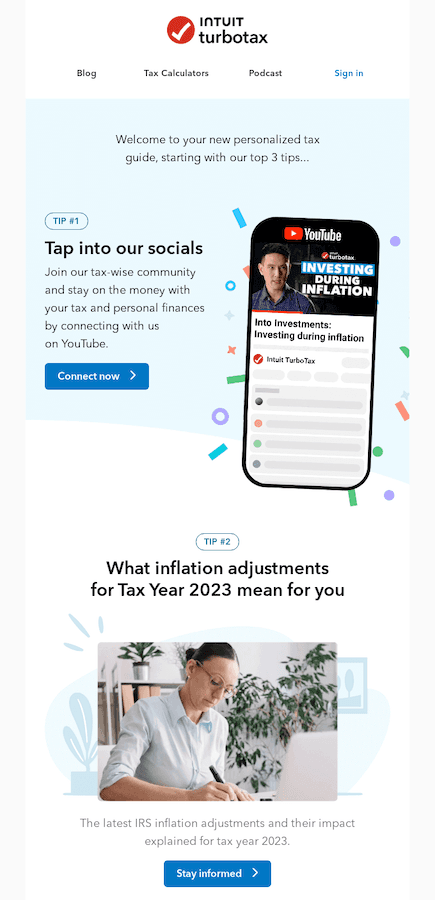
It shows they understand the stress of tax season and offer a tailored solution right from the start.
Leverage the power of storytelling
Connect emotionally by sharing a relatable story or anecdote highlighting the benefits of dealing with you. This humanizes your brand and creates a connection with your prospect.
You could write something like,
"Remember when [major event or trend] happened? Our company was founded to address the challenges that arose from that situation. We’ve helped countless businesses like yours overcome similar obstacles.”
Use a call to action (CTA) that converts
Tell your prospect exactly what you want them to do. For example, “I'd love to schedule a quick call to discuss how [product] can benefit your team. Are you available next week?”
You can also create urgency by using a limited-time offer or a sense of scarcity to encourage action. For example, you could say, “We’re only accepting five new clients this month—secure your spot before the opportunity closes.”
Build credibility with social proof
You’re scrolling through your inbox, and you come across two emails offering similar products. One email discusses the features, while the other starts with, “Over 5,000 companies, including industry leaders like Google and Amazon, use our platform to drive results.” Which email are you more likely to trust?
Humans are naturally influenced by what others do, especially if it’s a company or industry they respect. Social proof adds instant credibility to your email and reassures prospects they’re making a safe choice.
Make sure you weave in names of trusted clients, customer testimonials, or impressive stats to give your prospects a reason to trust you before they even start reading the details.
Use videos for complex explanations
Record a short video using a screen recorder and sales video software like Loom to explain the solution or walk through your product. Then, copy and paste the video link to embed it in your email.
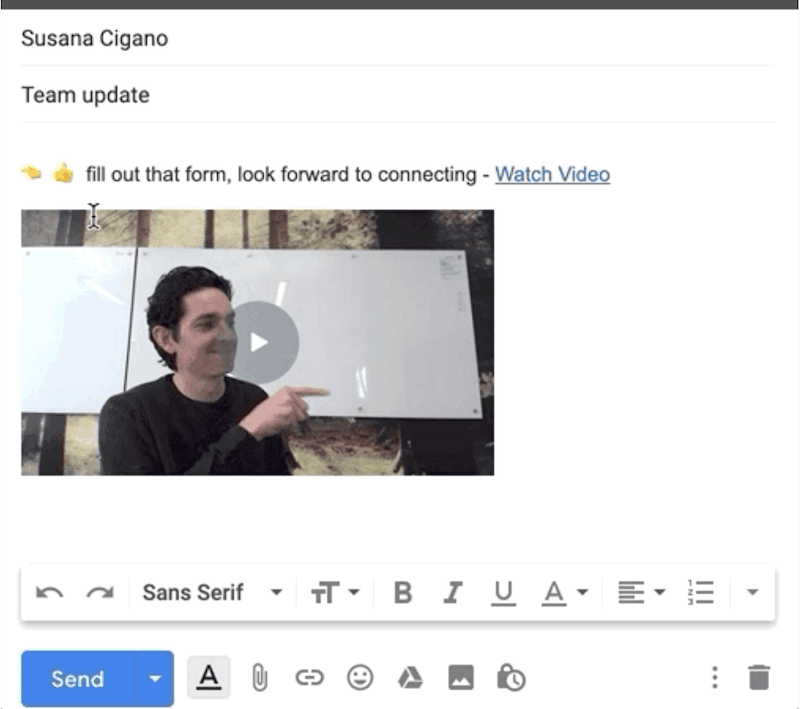
Let’s say you’re introducing a software feature. You can record a quick Loom video showing how it works in real time. A simple sentence like, “I recorded this quick video showing how we can streamline your workflow—check it out here,” with the video embedded, adds a personal touch.
Pro tip: A/B testing your emails, from subject lines to CTAs, can help you discover what resonates best with your audience.
Try testing two different subject lines—one that’s more direct, like “Cut your marketing spend by 30%,” versus one more curiosity-driven, such as “Are you spending too much on ads?”. Compare the open and response rates to find what works best.
3. Leverage social listening
You’re at a restaurant and overhear a nearby table discussing the exact type of product you sell. They’ve listed all their problems and needs, eagerly wishing for a solution they’re satisfied with. Equipped with the remedy, you casually join the conversation and offer the perfect solution to their problem.
That’s what social listening does—only in an online setting. It lets you “eavesdrop” on online conversations and identify your prospects’ pain points, preferences, and unique challenges so you can jump in at the right moment and provide tailored solutions. It’s about taking a proactive approach to sales prospecting rather than a reactive one.
To make the most out of social listening, you’ll need tools like Hootsuite, Brandwatch, or Sprout Social to track conversations across various online platforms in real time.
These platforms track relevant social mentions, keywords, hashtags, and competitor activity, telling you what people say about your industry, brand, or products.

For example, if you sell productivity software, track terms like “time management issues” or “project deadlines.” The tool will send you alerts when these keywords are mentioned so your sales team can jump in and contact new prospects at the right time, enhancing your SaaS sales prospecting and outbound strategy.
Social listening also helps you tap into trending topics that resonate with your target audience.
A great example of this is Australian Lamb’s 2024 ad campaign. In the months leading up to January 2024, the brand realized that the term “generation gap” was a hot topic of conversation and was mentioned almost 27,000 times on social media.
Australian Lamb seized this opportunity by creating a fun, relatable ad that played on generational stereotypes.
The ad resonated well with consumers, generating over 1.4 million views and global brand awareness.
Tracking such trends will help you create content based on your prospect’s needs, build relationships, and drive sales.
4. Social selling
Back in the 1970s, cold calling was the gold standard for sales prospecting. Sales reps would spend hours dialing potential sales leads, hoping for just a few minutes of conversation.
This worked when buyers had limited access to information. Today, buyers are inundated with information, reviews, and choices. They don’t want to be “sold to”—they want a relationship.
Enter social selling, which involves using social media platforms like LinkedIn, Twitter, and Instagram to connect with prospects, build relationships, and drive sales.
It’s about being part of their world, just like those local merchants in ancient marketplaces who built relationships with frequent buyers. Social selling allows for that same relationship-building—only now, it happens digitally.
So, how do you use social selling to provide value, share insights, and position yourself as a trusted adviser? Here are some actionable sales prospecting tips:
Share valuable content: Regularly share informative and engaging content that resonates with your target audience. For example, the famous CRM software HubSpot uses social media to share product updates, entertaining skits, and sales tips in a fun and relatable way.
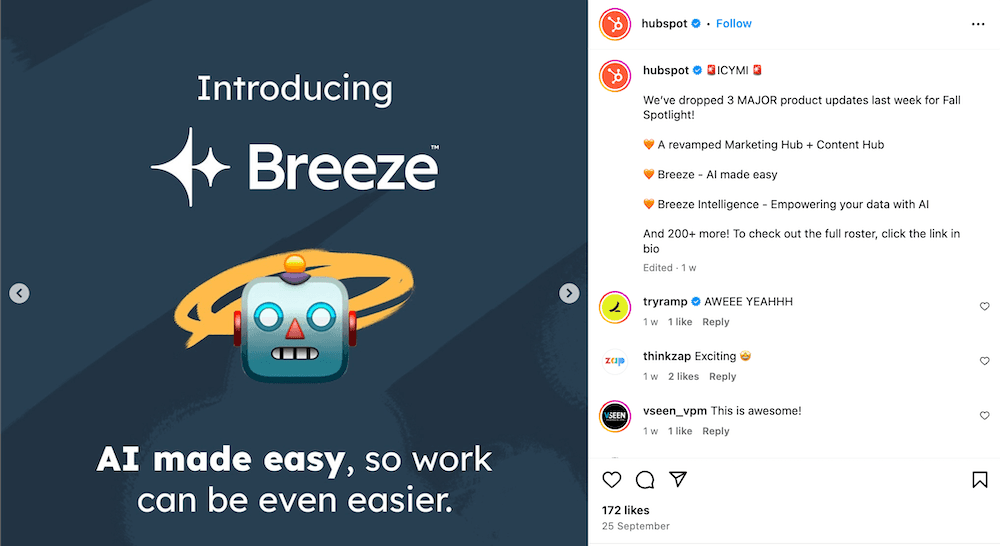
Engage with your audience: Respond to comments, messages, and questions to build relationships and demonstrate your social presence.
Create personalized video messaging: Video prospecting is a powerful tool in social selling. It adds a personal touch to your outreach, making your communication more engaging and memorable. Loom is a great tool for this—you can use it to record and share personalized videos or create explainer videos, conveying your message with the warmth and personality that text or an image alone often lacks.
4. Referrals
Imagine getting leads that are pre-warmed, trust you before you’ve even said a word, and close faster than cold prospects. That’s the power of referrals.
Referrals are word-of-mouth marketing on steroids. It’s when satisfied customers recommend your product or service to their friends, family, or colleagues.
When someone refers your business, it’s an endorsement. The person referring has already done the heavy lifting, vouching for your credibility and value. This reduces the skepticism that usually comes with cold outreach.
In fact, in B2B sales, 65% of a company’s new sales result from referrals.
To leverage referrals in sales prospecting, use these tips:
Ask for referrals at the right time: Ask for a referral when the customer is happiest with your service—right after a successful project, a positive outcome, or a stellar review. This is when they’re most likely to introduce you to others.
Track and reward referrals. Use a referral tracking tool to monitor your program’s performance and reward successful referrals. Incentives like discounts, exclusive offers, or even cash rewards can encourage more referrals as long as the incentive aligns with the value you’re offering.
Make the referral process easy. The easier you make it, the more likely it is to happen. Offer digital referral links, provide simple instructions, or even automate the process through your CRM or sales tools.
5. Content marketing
In the late 19th century, John Deere’s The Furrow was content marketing ahead of its time. Instead of pushing products, it provided valuable farming tips, building customer trust.
Today, that same approach—educating, entertaining, and informing—remains at the forefront of creating strong, long-term relationships.
That’s what makes content marketing stand out. Whether it’s blog posts, ebooks, videos, or case studies, content marketing allows you to nurture leads by offering insights before your prospects are ready to buy.
According to a report by the Content Marketing Institute, 67% of marketers experienced an increase in demand and leads from their content marketing efforts.
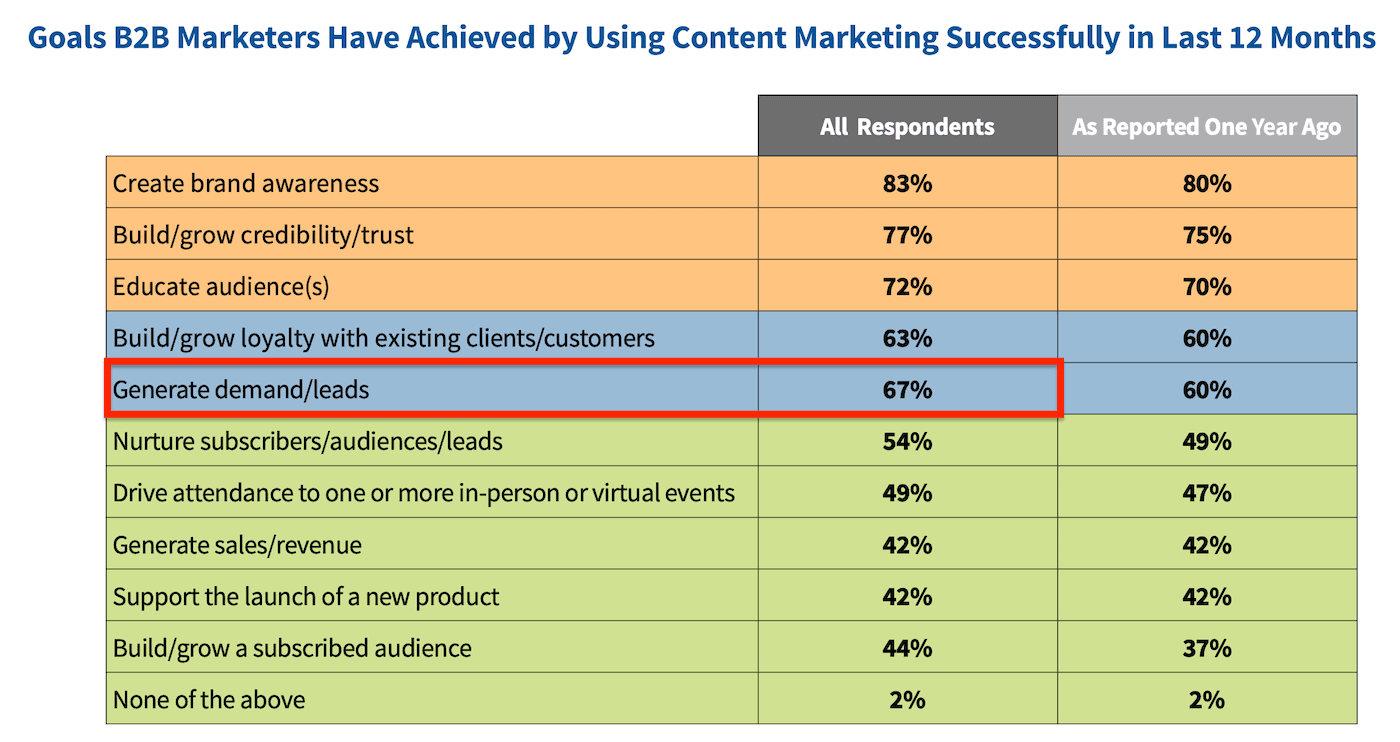
When done right, content marketing establishes your brand as a trusted resource. Here are some quick tips to help you get content marketing right:
Create educational content: Offer how-to guides or insights that solve your audience’s problems, like HubSpot’s marketing blog. They produce detailed articles about marketing and sales strategies that help their target audience solve problems, which builds trust and keeps them coming back.
Use gated content: Exchange valuable resources, like research papers and ebooks, for contact information.
Share case studies: Highlight success stories to show real-world results and build credibility.
Incorporate video: Use video tools like Loom to create quick, engaging product demos or explain the sales process with video. Loom’s own knowledge base features videos that break down product features and showcase its use cases, making it far easier for users to understand than text-based guides.
6. In-person networking events
You’re at a conference, surrounded by people in your industry. The buzz of conversation fills the room, and opportunities are everywhere—but how do you turn a casual chat into a potential deal?
Networking events are an excellent opportunity for sales prospecting, but you must know how to navigate them.
Here are some tips to help you make the most of networking events:
Prepare and research beforehand. Before attending, research key attendees, speakers, or companies that will be present. Craft a few talking points or questions that can start meaningful conversations.
Listen first, sell later. Ask thoughtful questions to understand your prospect’s business needs, and wait for the right moment to introduce how you can help.
Follow up immediately. Send a follow-up email or message within 24 to 48 hours, reminding them of your conversation and offering value, such as a helpful article, a webinar, or a solution to a problem they mentioned.
Pro tip: Use networking apps like Bizzabo or Attendify to track your contacts and conversations and make follow-up emails more personal.
7. Account-based marketing (ABM)
When fishing with a net, you catch anything that happens to swim by. But when spearfishing, you carefully target the right fish and find a perfect catch.
That’s the essence of account-based marketing (ABM), which includes tailoring your sales prospecting strategy to deliberately pursue high-value accounts rather than relying on chance.
Here are some ways to get started:
Identify high-value accounts
ABM starts with identifying the right accounts, so look for companies that closely match your ICP: those with the budget, need, and decision-makers aligned with your offering.
For example, an ideal account for a SaaS company might be a midsize tech firm with 200 to 500 employees and $10M+ in annual revenue.
As it expands, this account might have trouble growing its collaboration tools and practices. Its main issues would include misalignment between departments, poor communication, and challenges integrating various software into its tech stack. These companies usually look for easy-to-use, customizable solutions that can be quickly set up and deployed.
Here’s an example of an ideal customer profile template:
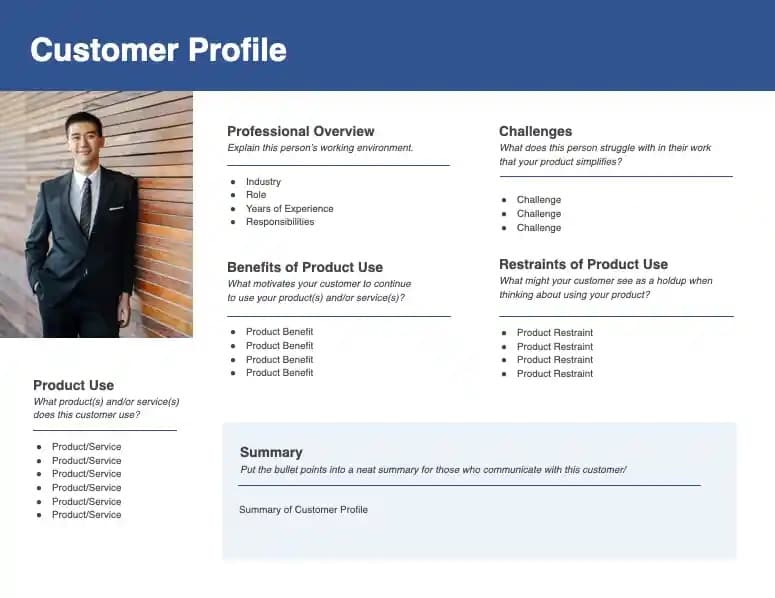
Personalize your outreach messaging
Once you identify your ideal customer, their expectations, and their pain points, it’s easier to create content that speaks directly to their goals and challenges and moves them further down the sales pipeline.
If you’re targeting a tech company struggling with scaling, you could send a relevant case study highlighting how your product helped another tech client facing a similar issue—rounding out your value proposition with social proof.
Pro tip: Capture a relevant case study with a Loom video to make your pitch more engaging and personalized. As you speak, you can highlight important data and insights.
For your prospect, hearing your voice, seeing your face, and observing nonverbal cues make your message more memorable and impactful. Seeing that you took the time to record a video will also make them feel more special.
8. Cold calling
Cold calling is akin to salespeople knocking on doors in the digital age—only now, it’s through a phone call rather than a doorbell.
For the uninitiated, cold calling involves making direct calls to prospects to introduce your product or service, aiming to pique their interest and secure a follow-up meeting or sale.
To make your calls more effective, start by doing your homework. This means researching your prospect’s needs and preferences before you pick up the phone. The more you know, the better you can appeal to the new prospect.
With that information in hand, craft a flexible and conversational script. Your script should focus on how you can solve their issues rather than just listing features. Addressing their pain points will help you build a mutual connection and a meaningful customer relationship.
Transform your sales prospecting strategy
To truly excel in the sales prospecting process, you need to do more than generate leads. You need to build relationships to reach qualified leads that turn into paying customers and brand advocates.
To acquire qualified prospects and boost conversion rates, it’s important to implement a mix of effective prospecting and lead-generation techniques and personalize every interaction.
With Loom, you can further improve your outreach by creating engaging, tailored videos that offer a human touch and help your messaging stand out.
So why stick to cold emails or endless slide decks? Create content that speaks directly to your prospects—try Loom’s screen recorder today to engage potential buyers and transform how you connect.
